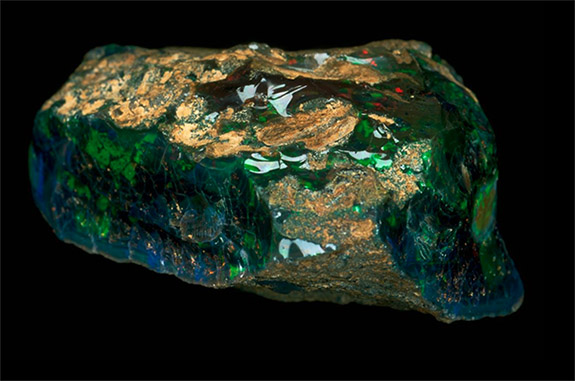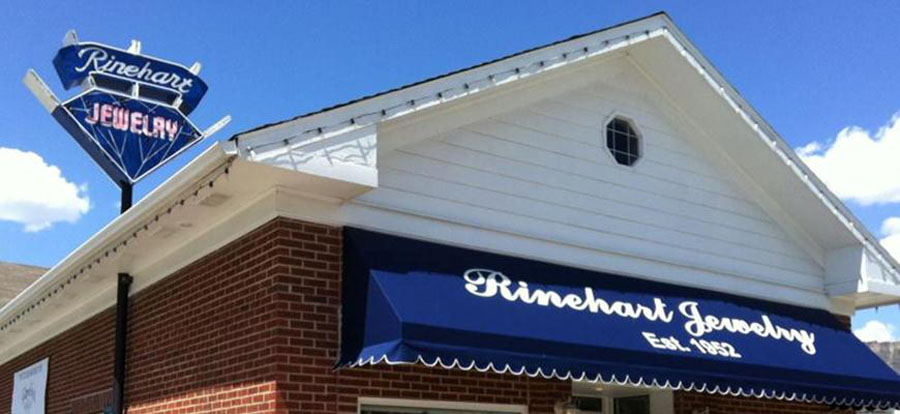October 5th, 2021
A gift from engineer and philanthropist John A. Roebling II to the Smithsonian in 1926, this 2,585-carat opal specimen is an extraordinary example of October's official birthstone.

More than 95% of the world’s gem-quality opals originate in Australia and the finest black opals are commonly sourced at Lightning Ridge — an Aussie mining area that has been yielding top-quality opals since 1903.
But, what's unique about the opal seen in the photo, above, is not only its size, but its origin. It was discovered in Virgin Valley, a dry and isolated area of southeastern Nevada just 15 miles from the Arizona border.
The Smithsonian explained that "The Roebling Opal" formed in an unusual way. Scientists believe that this now-arid area was once the location of a large lake and lush forests. The area was devastated by volcanic eruptions that buried the area under layer upon layer of ash. Over time, silica-rich water collected in voids that remained after buried tree limbs had rotted away. In some cases, opals from Virgin Valley resemble casts of the original tree parts.
Opals with a vivid play-of-color and a black or other dark body color are called black opals. The Roebling Opal is a black opal with flashes of blue and green play-of-color. Other varieties of October's birthstone include white opals, boulder opals, crystal opals and fire opals.
An opal’s silica structure contains 3% to 20% water, according to the American Gem Society. The value of a fine opal is based on a number of factors, including brightness, color, pattern, body tone and consistency (how it looks from multiple angles).
While Australia remains the primary source of fine opal production, the October birthstone is also mined in Mexico, Brazil, Honduras, Ethiopia, the Czech Republic and parts of the U.S., including Nevada and Idaho.
Today's featured stone had been owned by John A. Roebling II, who was named for his famous grandfather, the original designer of the Brooklyn Bridge.
John A. Roebling is credited with being the mastermind behind one of most impressive engineering feats of the 19th century — a suspension bridge that would span 1,595.5 feet, linking Brooklyn and Manhattan. The 14-year project was started in 1869, the same year Roebling would pass away at the age of 63.
Roebling’s son, Washington, supervised the construction of his dad’s vision, with the assistance of his wife, Emily. On May 24, 1883, the Brooklyn Bridge was unveiled to the world during a celebration attended by President Chester A. Arthur. More than 150,000 people earned the privilege of crossing the bridge on opening day.
Besides being a world-class engineer, Washington Roebling was an avid collector of rocks and minerals. Upon his death in 1926, Roebling’s collection of 16,000 specimens and an endowment of $150,000 for its maintenance were donated by his son, John A. Roebling II, to the Smithsonian Institution.
The collection, which included the The Roebling Opal, has become an integral part of the National Gem Collection.
Credit: Photo by Chip Clark / Smithsonian.

More than 95% of the world’s gem-quality opals originate in Australia and the finest black opals are commonly sourced at Lightning Ridge — an Aussie mining area that has been yielding top-quality opals since 1903.
But, what's unique about the opal seen in the photo, above, is not only its size, but its origin. It was discovered in Virgin Valley, a dry and isolated area of southeastern Nevada just 15 miles from the Arizona border.
The Smithsonian explained that "The Roebling Opal" formed in an unusual way. Scientists believe that this now-arid area was once the location of a large lake and lush forests. The area was devastated by volcanic eruptions that buried the area under layer upon layer of ash. Over time, silica-rich water collected in voids that remained after buried tree limbs had rotted away. In some cases, opals from Virgin Valley resemble casts of the original tree parts.
Opals with a vivid play-of-color and a black or other dark body color are called black opals. The Roebling Opal is a black opal with flashes of blue and green play-of-color. Other varieties of October's birthstone include white opals, boulder opals, crystal opals and fire opals.
An opal’s silica structure contains 3% to 20% water, according to the American Gem Society. The value of a fine opal is based on a number of factors, including brightness, color, pattern, body tone and consistency (how it looks from multiple angles).
While Australia remains the primary source of fine opal production, the October birthstone is also mined in Mexico, Brazil, Honduras, Ethiopia, the Czech Republic and parts of the U.S., including Nevada and Idaho.
Today's featured stone had been owned by John A. Roebling II, who was named for his famous grandfather, the original designer of the Brooklyn Bridge.
John A. Roebling is credited with being the mastermind behind one of most impressive engineering feats of the 19th century — a suspension bridge that would span 1,595.5 feet, linking Brooklyn and Manhattan. The 14-year project was started in 1869, the same year Roebling would pass away at the age of 63.
Roebling’s son, Washington, supervised the construction of his dad’s vision, with the assistance of his wife, Emily. On May 24, 1883, the Brooklyn Bridge was unveiled to the world during a celebration attended by President Chester A. Arthur. More than 150,000 people earned the privilege of crossing the bridge on opening day.
Besides being a world-class engineer, Washington Roebling was an avid collector of rocks and minerals. Upon his death in 1926, Roebling’s collection of 16,000 specimens and an endowment of $150,000 for its maintenance were donated by his son, John A. Roebling II, to the Smithsonian Institution.
The collection, which included the The Roebling Opal, has become an integral part of the National Gem Collection.
Credit: Photo by Chip Clark / Smithsonian.


